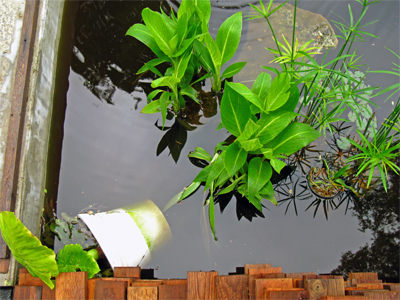Thanks to my visitors during Spring Fling and the article on garden blogging in the Austin American-Stateman, the image most people have of Zanthan Gardens is the meadow. The meadow defies all rules of garden sense. In a world seeking low-maintenance gardens with year-round interest, the meadow is a high-maintenance garden which has only one good season: from mid-March to mid-May. Although it has some Texas wildflowers in it, it is not primarily a native plant garden. As gardens go, the meadow does not have strong bones. You can barely see the garden for the flowers. There is little ornamentation. And despite photographic evidence to the contrary, there’s no place to sit in it–yet.
As I’ve often said, when it comes to the garden, I’m more of a plant person than a designer. Yet the meadow has both a design and a plan. The design is constrained by shade and one of the reasons I like an garden of annuals is because it’s easy to move the plants around as the light/shade conditions change.
December 18, 2007

By mid-December I have already been working in the meadow for over a month. First I have to clean out the summer weeds (mostly horseherb) and rake up all the leaves. As self-sown annuals sprout all over the yard, I transplant them in drifts. I make mini-beds in the buffalograss, add sifted compost, and then transplant larkspur, bluebonnets, and cilantro. People might think a wildflower meadow can be made by just broadcasting a few seeds and letting nature take its course but that doesn’t work effectively in a urban space–at least not for me.
I’ve designed the view so that it incorporates, rather than hides, the back yards of my two neighbors. I try to balance the drifts of flowers so that there is a back and forth rhythm–like a series of S-shaped switchbacks, or the flow of a meandering river, or something from Andy Goldsworthy. Trying to get the right balance of color and height blooming together and in succession is the challenge of the meadow garden–what keeps it interesting and fun year after year.
February 4, 2008

Two months later and I’m still transplanting. The rosettes of the larkspur, bluebonnets, and Engelmann daisies are big enough to mulch around. Because this fall and winter were so dry, I did more mulching of the meadow than I’ve ever done before. I start poppies and cornflowers in seedbeds and then transplant them into the meadow. Cilantro is filling in on its own.
March 5, 2008

A month later and larkspur is shooting up flower stalks. Bluebonnets are one of the earliest wildflowers to bloom. We had a mild summer in 2007 but a dry, hot fall. Almost all the bluebonnets that made strong plants this year actually sprouted last May and over-summered. The bluebonnets that came up when they’re supposed to in the fall, were small and had few flowers. Usually this time of year, the meadow is a sheet of blue.
Self-sown baby blue eyes and false dayflowers grow up along the back fence with no help from me at all. All I do to help it look more like a garden than a patch of weeds is weed out anything else so that flowers of one type are massed together. Drifts are the key.
April 3, 2008

All the anticipation is rewarded with a riot of color: blue from the bluebonnets, pink from the pink evening primrose, white from the cilantro, yellow from the Engelmann daisies, maroon from the cornflowers. If I’m lucky, the roses, crinum lilies, and irises are blooming too.
May 12, 2008

Even in while the garden is in full bloom I’m out “editing” it–pulling out flowers that have gone to seed, dead-heading to prolong the life of others, marking plants I want to save seeds from, and ripping out the ones I don’t so they won’t cross-pollinate. As the season winds up, the yellows take over.
May 15, 2008

This year, just as I had cleaned out most of the meadow, the top 20 feet of that cedar elm in the middle of these photos fell on the meadow. I’m lucky that it missed the retama (in full bloom with yellow flowers), the sago palm, and the roses and Japanese persimmon (not in this picture). The variegated agave, the Lindheimmer senna (which was just filling out) and the crinum lilies were somewhat crushed but the damage relatively minor.
May 24, 2008

Cleaning up the fallen tree limb put me a week behind on my tidying and mulching the meadow. A few stray spring flowers continue to bloom. The self-sown cosmos, annual black-eyed Susans, and clammy weed get along without any help from me–which is great because the heat and humidity are oppressive right now.
Extending the Season
I do have strategies for extending the season. I’ve tried planting sunflowers and morning glories but I they get too late a start to bloom well before the heat. I have better luck planting them in the fall.
I’ve had several trees removed so that there is more light in the meadow again. Now I’ll be able to replace several roses I’ve lost. Also I’ve been planting more ornamental grasses, succulents, and perennials (like Lindheimer senna). Pam/Digging has been passing along her sun-loving plants, zexmenia, perennial black-eyed Susans, and purple coneflowers. This year I decided that the hot, sunny meadow might be the best place for some summer vegetables. Peppers are my favorite because the plants are so attractive. But during the suffocating heat of summer, I prefer to keep the planting airy and open; I need room to breathe.


































